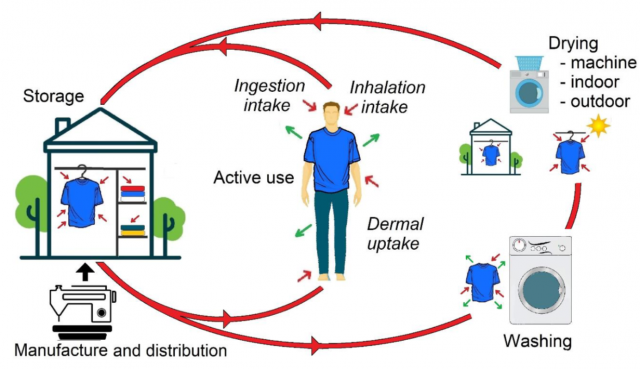By Dusan Licina (EPFL – École polytechnique fédérale de Lausanne,@licinadusan), Glenn Morison (University of North Carolina, @gcmorr), Gabriel Bekö (Denmark Technical University) Charles Weschler (Denmark Technical University and Rutgers University,@CJWeschler) and William Nazaroff (University of California Berkeley)

Take a couple of seconds to think about how much time we spend every day wearing clothing – whether we work, play or rest. We spend the vast majority of our lives in close contact with clothing and other textiles. There is growing evidence that the clothing that we wear exposes us to various chemicals and particles on a daily basis – and that this exposure could carry significant health risks. Yet, we know surprisingly little about what contaminants we carry with us in our everyday clothing. Should we be concerned?
Our recent paper summarized and critically assessed evidence from 260 research papers on how wearing clothing exposes us to various chemicals and particles. While in some cases our clothing can act as a protective barrier against environmental hazards, clothing can often expose us to potentially toxic chemicals and biological particles (such as microbes and allergens) by acquiring and releasing such substances that can end up in our lungs. From the indoor environment, clothing can accumulate, for example, nicotine residue from cigarette smoke, plasticizers, flame retardants and microbes from pets and people. In occupational settings, clothing can pick up hazardous compounds used in the farming, medical and manufacturing industries. In addition to contaminants that clothing acquires from our surroundings, we should think of those that are present in clothing at the time of purchase as a consequence of manufacturing processes (e.g., dyeing, bleaching, finishing) or that have been deliberately added and are intended to be retained during the life of the garment. Some representative materials of possible concern include flame retardants, antimicrobial nanoparticles, pesticides, anti-wrinkle resins and other coating materials. Some chemicals on clothing can be chemically transformed to other species, to which we are then exposed during wear. Depending on how we use and treat the fabrics, some substances are removed through washing, drying and storage; others persist and can contribute to our exposures over the life of the garment.
We certainly need more evidence about health risks before policies for clothing contaminants can be considered. In the meantime, an admissible requirement could be that clothing contain a label indicating not just what materials it is made from, but also what substances (e.g., flame retardants, perfluorinated surfactants, UV filters) it was treated with in the fabrication process – much like the ingredient and nutrition-information labels that are required on food. On the other hand, we only have a preliminary understanding of connections between human exposures and several contaminants present in clothing. Much is speculative because we just don’t have the clear evidence how clothing-mediated exposures affect us on a day-to-day basis. A step towards overcoming that knowledge gap would be that chemists, biologists, environmental and textile engineers and epidemiologists work together to design and implement studies that would identify direct connections between clothing-associated exposures and health.
Learn more about this topic here:
D. Licina, G. C. Morrison, G. Beko, C. J. Weschler and W. W. Nazaroff, Clothing-Mediated Exposures to Chemicals and Particles, Environ. Sci. Technol., 2019, 53, 5559–5575 https://pubs.acs.org/doi/10.1021/acs.est.9b00272